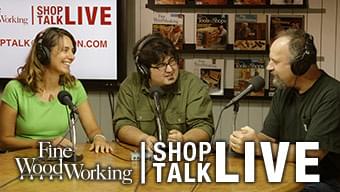I just bought a hard flet wheel to use for sharpening. I mounted it on my Shopsmith but the wheel does not run true. I have to remove some of the circumference before I can use it.
How do I do this without screwing up the felt wheel?
TIA,
Don
I just bought a hard flet wheel to use for sharpening. I mounted it on my Shopsmith but the wheel does not run true. I have to remove some of the circumference before I can use it.
How do I do this without screwing up the felt wheel?
TIA,
Don
Get It All!
UNLIMITED Membership is like taking a master class in woodworking for less than $10 a month.
Start Your Free Trial



UNLIMITED membership - Get access to it all
Start Free TrialGet instant access to over 100 digital plans available only to UNLIMITED members. Start your 14-day FREE trial - and get building!
Become an UNLIMITED member and get it all: searchable online archive of every issue, how-to videos, Complete Illustrated Guide to Woodworking digital series, print magazine, e-newsletter, and more.
Get complete site access to video workshops, digital plans library, online archive, and more, plus the print magazine.
Already a member? Log in
We use cookies, pixels, script and other tracking technologies to analyze and improve our service, to improve and personalize content, and for advertising to you. We also share information about your use of our site with third-party social media, advertising and analytics partners. You can view our Privacy Policy here and our Terms of Use here.
Replies
Mine ran perfectly true until an act of stupidity wrecked that. Last week I was polishing the curved part of the chipbreaker on a Stanley plane I was tuning up. They tell you to always have the rotation trail away from whatever you are buffing...well to make a long story short, I pointed the chipbreaker into the rotation of the wheel causing a near accident. The chipbreaker snapped back hard down onto the toolrest and a chunk of the hard felt wheel went flying. Now the wheel was unbalanced and useless (temporarily) due to the uneven surface. My own incompetence angered me and I quickly started thinking about how to return my expensive hard felt wheel to service. What I ended up doing was to take my lathe skew chisel to the rotating wheel into the rotation (on purpose this time, not by accident). My hypothesis was that I could carefully apply the bevel of the skew on the rotating wheel and "turn" the felt wheel round again. I was moderately successful as evidenced by the shower of wool fibers that blasted me. I then held a vacuum under the running grinder to catch the fibers and kept cutting with the skew. I checked my work periodically until the low spot from the missing chunk was even with the rest of the wheel. Needless to say, the wheel is now smaller and diameter and is no longer loaded with any polishing compound. the fibers are kind of squashed but the wheel runs true now. For some reason, the wheel does polish and runs true but is currently acting more like a soft to medium felt wheel now. If you try my method just be aware that putting a sharp tool directly in line with the rotation on a bench grinder is a potentially dangerous operation, use the toolrest as a fulcrum and only remove a small amount of the wheel at a time. You will know if you are bearing down too hard if the grinder slows down much.
Good Luck Don!
Well, as long as we're introducing dangerous but potentially workable solutions, here's what I'd consider doing: introducing a knife edge (utility knife?) from the side of the wheel. Would definitely need a resting surface to use as a fulcrum and steady. Very gradually advance the point of the knife to the spinning wheel's side, with the rotation going in to the knife's edge.
Let this one age for awhile and see if any of the pros object. I totally made it up.
forestgirl -- you can take the girl out of the forest, but you can't take the forest out of the girl ;-)
Another proud member of the "I Rocked With ToolDoc Club" .... :>)
FG, use a running disc grinder or flapwheel in a reversable drill and gently apply to rotating wheel The two wheels have to run in opposing directions.
I have trued up, or shaped grinding stones like this for years.( stone to stone)'
Want to put a sharp point on a rod or center punch
Rod in drill chuck drill in reverse(Anti clockwise) Grinder going clockwise
Steinmetz
I bought the curved wheel for carving tools from Lee Valley. Did the same thing as you and put about a 1/4" deep cut in it. I looked at the instruction sheet that came with it and it said that to true it up to use a drum sander spindle with I cannot remember what grit paper on it. My inside radius was something like 3/8" so I wrapped sandpaper around a dowel and cleaned up the inside and outside radius. The cut is still there but it runs totally true and makes no noticeable difference whatsoever. I would just put sandpaper on a block and true it up with that.
This forum post is now archived. Commenting has been disabled